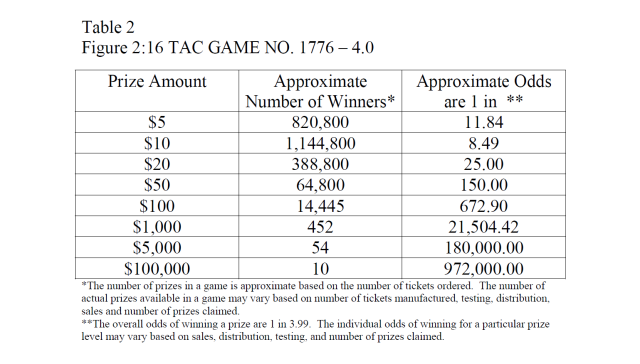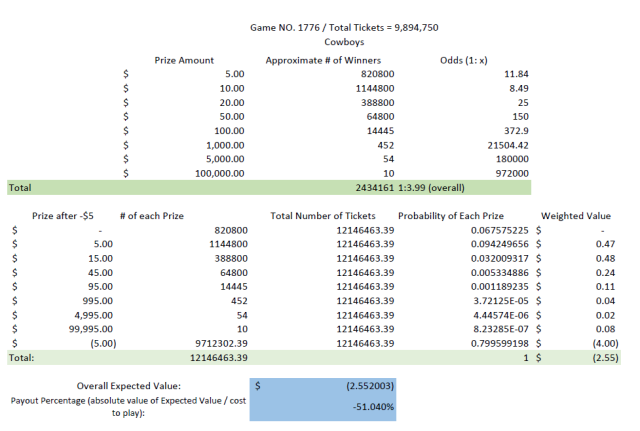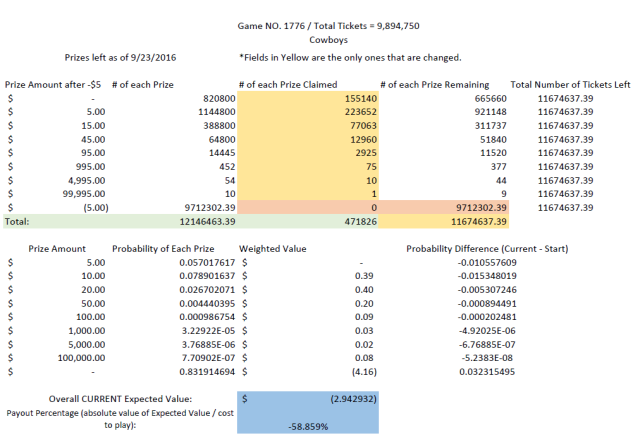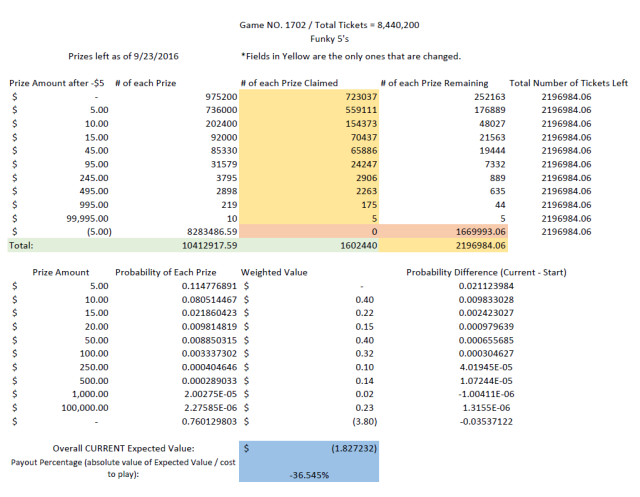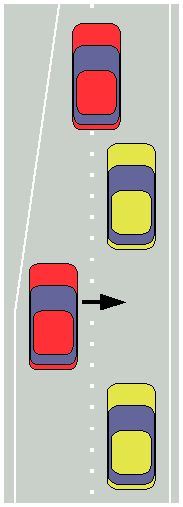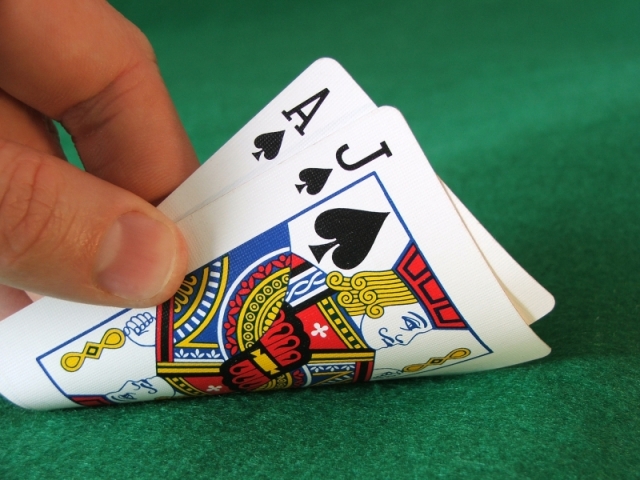
Casinos are great places of entertainment. They have many sights and sounds everywhere. It’s almost a bit overwhelming to walk into your first casino ever. You have a room full of slots, an area for table games, restaurants, bars, decor, and much much more. It’s an awe in itself. An architectural wonder!
Now I won’t get side tracked by the casino ambiance. I am here to focus on one of the most popular table games in the casino: Blackjack. Also know by the name “21 ” or “Twenty-One”, blackjack is popular because of its simple premise in comparison to other table games that use cards. Before I delve into the world of card counting, you have to know how to play first.
Section I: How Blackjack is Played
**If you know how to play Blackjack and are familiar with the table, the game, and the process, skip this section and go to the next one**
In Blackjack you have players and a dealer. All of the players are against the dealer and no player is against each other. The goal is to obtain a total as close to 21 or to have exactly 21 while also beating the dealer’s total. A tie, where you and the dealer have the same score, results in a “push” meaning no one wins. If one of you goes over 21, it is called a bust. If you’re the player and you bust, you are out of the hand and lose all of your money for that round. If the dealer busts, everyone who is still in the game wins automatically. Really easy concept. Here are the card values:
- Numbered cards (2 through 10) are worth their respective value.
- Face cards (Jack, Queen, King) are worth 10
- Aces are worth either 1 or 11. If say you have an ace, a 9, and a 2, instead of your total being 22 (that would bust you), you count it as a 1 instead. You count aces as 11 when your total is under 21 while counting it as 11. If your total exceeds 21 with the 11, the ace is counted as a 1 instead. So if you have an ace and a 7, this would be 18 which would be called a SOFT 18 because the ace is being used as an 11. If you have an ace, 7, and 6, you now exceed 21 and the ace is treated as a 1 so you now have a total of a HARD 14 because the ace is now used as a 1 instead of an 11.
Every game begins with the players and the dealer being dealt 2 cards. Player cards are dealt facing either up or down depending on how many deck of cards are being used in the game. The dealer will always have one card down (called the hole card) and one card face up.
Now in order to obtain a “Blackjack”, or also known as a “natural”, the player’s first two cards that are dealt must add up to 21. The only way to do this is to have any face card and an ace dealt out. Naturals/Blackjacks result in an automatic win if the dealer does not have a blackjack too (that would be a push) and you are paid out immediately.
Before going into more rules, you will need to know the layout of the table as illustrated below:
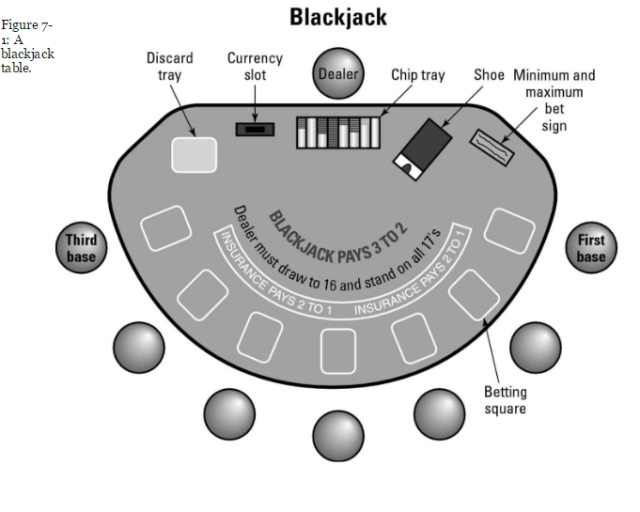
Basic Blackjack Table Layout (Blackwood)
Before I go into detail on the terminology above, let’s know how the cards are dealt out. At the beginning of a game, the dealer will dispose a card (or “burn” a card in Blackjack lingo) and begin dealing out the first card starting from First Base to Third Base and then dealing one to himself. The second card is then dealt out beginning with First Base all the way to Third Base where then the dealer deals out his/her last card face up.
Now let’s summarize what you see:
- First Base: Where the dealer deals first. First base makes decisions first before any other player.
- Third Base: The last player to act.
- Min/Max Bet sign: The table will always mark the minimum bet required for each round along with the max you can bet in a round.
- Shoe: Where the decks of cards are held. A shoe will be used for 4, 6, and 8 deck games. For 1 or 2 deck games the dealer will deal straight from his/her hand.
- Chip Tray: Where the dealer keeps all of the casino chips.
- Currency Slot: When you buy into a game (give the dealer actual cash in exchange for chips worth the same amount), he/she will put your money into this slot.
- Discard Tray: Where all discarded cards go.
- Blackjack pays 3 to 2: When you obtain a blackjack, this table will payout a 3 to 2 ratio for your win. So if you bet $10 initially and receive a blackjack, instead of winning even money (like a normal win) which would be $10, you win $15 which is a 3 to 2 ratio. Be wary as not all casinos pay 3 to 2 for a Blackjack. Some pay 6 to 5. STAY AWAY FROM THESE TABLES.
- Dealer must draw 16 and stand on all 17’s: If the dealer has a total of 16, he must draw until he has 17 or above. Not all tables have draw on ANY 17. Most will say “Dealer must hit soft 17” (implying he stands on hard 17).
- Insurance pays 2 to 1: Don’t worry about insurance. Even card counters never use it but only in dire situations. I will explain this later.
After being dealt two cards for everyone, you examine your cards and see if you want to HIT (ask the dealer for another card) or STAND (stating you don’t want any cards). The dealer starts this process with whoever is closest to First Base. This process is done once per round.
So if I have a 6 and a 3, my total is 9. I want to HIT for another card. I receive another 3. Now I have a total of 12. I probably want to HIT again. I receive a 6. I now have a total of 18. I could gamble and go for the the 21, but I know that’s not the right choice. I choose to STAND. The dealer then goes to the next player to the dealer’s right side (the player’s left) and goes through the whole process again.
After all players have completed their decisions, the dealer then flips over the hole card (remember the one facing down) and takes that total. If the total is under a HARD 17, the dealer keeps drawing until he has either ABOVE a SOFT 17, equal to a HARD 17, or above a HARD 17. If the dealer busts, everyone who hasn’t busted wins automatically. If the dealer does not bust and meets one of the above requirements, the totals are then compared. Anyone the dealer beats loses their money. Anyone the dealer ties, a push happens. Anyone who beats the dealer, the dealer pays out even money. So if I bet $5 and I win, the dealer gives me $5 and I keep my original $5 so I profit $5.
Now Blackjack isn’t only about hitting and standing. The players have some other options that work in their favor:
- Double Down: The player has the option to double down on his/her first two cards. So if I am dealt a 5 and a 6, I want to double down. Doubling down allows me to place an extra bet equal to my original bet while receiving only 1 card for my turn from the dealer. So if I bet $5 and I got lucky and received a total of 11, I want to double down and press my luck. So I push out another $5 to signal to the dealer I want to double down. He/she then proceeds to give me only one card and places it face down to be revealed at the end of the round. Some casinos may only allow you to double down on a total of 9, 10, or 11 while others let you double down on whatever you want.
- Split: If my first two cards are the same card (two 2’s, two 10’s, two queens, etc.), I am allowed to split them and treat them as two separate hands as long as I bet an equal amount to my initial bet. A total of 16 is a terrible total known as a “stiff” and it’s hit or miss when deciding if you want to HIT or STAND. So if I have two 8’s, this is my way out of having a total of 16. If I bet $5 initially, I signal to the dealer that I want to split by introducing another $5 on the table to split the cards. Now I have two separate hands treated independently of one another. The dealer will immediately deal one extra card to each 8. So if on my first 8 I receive a 9, my total is 17. I choose to STAND. If on my next 8 I receive a 3, I have a total of 11. I can then choose to HIT or even take the Double Down option as mentioned above. It’s up to the player. Now there are two distinct scenarios that may come up.
- If you are dealt two aces, you can choose to split them (you should), but when the dealer gives one card per ace, you normally aren’t allowed to hit on top of that card. This is really dependent on the casino’s rule for that Blackjack table as not allowing the player to hit on top of this ace favors the casino’s odds. If you had the option to hit, this favors the player’s odds.
- Say I am dealt the two 8’s again and on one of those 8’s I am dealt ANOTHER 8. Most casinos will allow you to re-split those 8’s resulting in now 3 hands at play. Depending on the casino’s rules, you could re-split your numbers continuously if you’re up to it. [I had this happen to me once. I had two splits which resulted in 3 hands on the table for me. One of them I double downed on. At a $5 table I had a total of $70 on the table for that one round. I lost it all even when following card counting strategies. Bummer…]
- Surrender: Not many casinos offer this option but there are some out there. Say your hand isn’t looking too good and the dealer has a strong card facing up (I will discuss that later). If the casino has the surrender option, I can choose to surrender which results in the dealer keeping half of my original bet and I get to keep the other half. It’s the perfect example of cutting your losses.
- Insurance: If the dealer’s up card is an ace, the dealer will tell all of the players “Insurance is open.” An ace as the dealer’s up card is bad for the players because the dealer could have a possible blackjack by having any card with a value of 10 as his/her hole card. If the dealer has a blackjack, all players who have under 21 as their total automatically lose. If you tie (meaning you have a blackjack too), this results in a push. The insurance option is a side bet meaning you would make an extra bet to bet that the dealer has a blackjack. You would do this because you may lose all of your original bet if the dealer beats you so this side bet may make up for your loss. The players then decide if they wish to execute the insurance option. The dealer will then say “insurance is closed” and will reveal the hole card. If it is a card with a value of 10, every player sighs and loses their money or pushes. If the dealer does not have a 10, then normal play goes about. If you took the insurance option, you are paid 2 to 1 on that side bet if the dealer did have a blackjack but you still lose your original bet. If the dealer did not have a blackjack and you made the insurance bet, you lose the insurance bet but keep your main bet. That’s it for insurance but the most important thing you need to know is that generally insurance is a SUCKER bet. Just don’t ever take it.
Lastly, most (if not all) Blackjack tables will have something called a “side bet” on the table for the player to bet on. There are a ton of side bets out there. Click here to check out a list from Wizardofodds.com (a great site to check out odds/probabilities of most casino games).
A side bet is made before the cards are dealt. One popular side bet is the “Lucky Ladies” side bet. Here is an example of one of the Lucky Ladies variant.
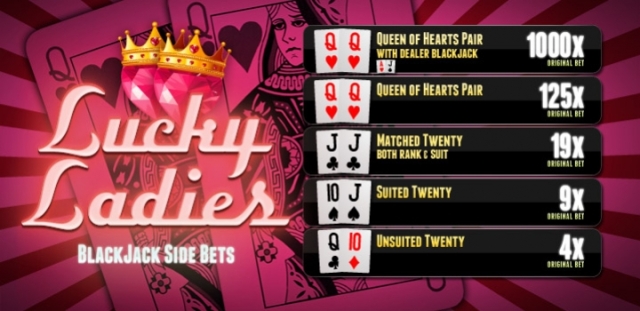
If a new round of Blackjack is about to start, I can put say $1 in the side bet circle. For this side bet, if my first two cards result in one of the above examples, I win that much on my original bet. So if I bet $1, I could win either $4, $9, $19, $125, or $1000. If I bet $5 on it, I could win $20, $45, $95, $625, or $5,000. If I don’t win, my bet is taken immediately and I lose it. The probability on winning a side bet is low and most people consider them sucker bets.
I normally won’t play side bets. The odds are generally terrible. There is one side bet that I found at the Tropicana in Las Vegas that bets if the dealer will bust. If you are card counting and the count is low (described later), there is a better chance of the dealer (and me), busting. So if the count was low I would put $5 in hopes the dealer would bust. If I won, the bet paid 2 to 1 so I would win $10 and keep my original $5. If the dealer did not bust, I lost my $5. I am not certain on the odds/probability of winning/losing on this side bet with card counting involved. I even e-mailed an author, Kevin Blackwood, who wrote the book Play Blackjack Like the Pros. He said he wasn’t familiar with the bet and couldn’t offer any insight on it. Regardless, if you’re a normal player, don’t take the side bets.
Now that you know the rules and how to play Blackjack, let’s go into why Blackjack is different from the rest of the games in the casino.
Section II: How Blackjack is Unique
Before we look into strategy, we need to compare Blackjack to other casino games. All casino games have probabilities and odds. Craps, Roulette, Blackjack, etc. all have different odds. Craps and Roulette are examples of where the events that happen in the game are independent of the past.
For example, in roulette you choose a number or set of numbers that the ball will land on. You either win or you lose. Then you repeat the process. What makes this an INDEPENDENT game is that the past DOES NOT affect the future. So if the ball lands on the number 6, the game starts again and it could land on the 6 again or something else. The last round does not affect the current round in any way, shape, or form. The chances of an individual number are 1 in 35 or 1/35. That’s a 2.86% chance of a particular number. So there is a 2.86% chance that the ball will land on the 6 in the past round. In the next round, it is STILL a 2.86% chance of it landing on the 6 again. The past does not affect the future. It could, in fact, land on the 6 ten times in a row and it would still be a 2.86% chance. So the game really is a stroke of luck.
Casinos will often put a big screen next to a roulette wheel to show what numbers have already landed to trick players into betting on other numbers. Really this trickery doesn’t help the player nor the casino. It’s there for superstition. If people see that the number 6 has already landed two times, some will think “wow it’s already hit 6 twice, I’m not betting on 6.” This is false thinking because the 6 is still likely to land again.
Now Blackjack is different. Once a particular card is dealt out of the game, it affects what’s left in the game. In Blackjack, high cards (10’s and face cards) FAVOR the player and low cards (2 through 6) HURT the player. So if the deck has a lot of high cards remaining, your chances of winning increase. If the deck has a lot of low cards remaining, your chances of winning decrease. Dr. Edward Thorp is thought to be the “father” of card counting as he noticed this trend and ran many extensive programs analyzing the statistics on it. Without digging into the math, he found his hypothesis to be true.
Since what’s remaining in the deck either favors or hurts the player, we can see that the past DOES affect the future. This is called a DEPENDENT game as the future does depend on the past. The past does affect the future and that is why Blackjack is unique.
Next I will introduce Basic Strategy which every card counter has to learn to a T before actually counting cards.
Section III: Basic Strategy
This is the first stepping stone into card counting. Even if you are not interested in card counting, this strategy will help curve the odds a bit more in your favor although the casino will still have them in their favor.
Basic strategy is dependent on the player’s total and the dealer’s up card. Certain decisions are made based off of the combination of these two things. Below is an example of a basic strategy chart pulled from The Wizard of Odds.
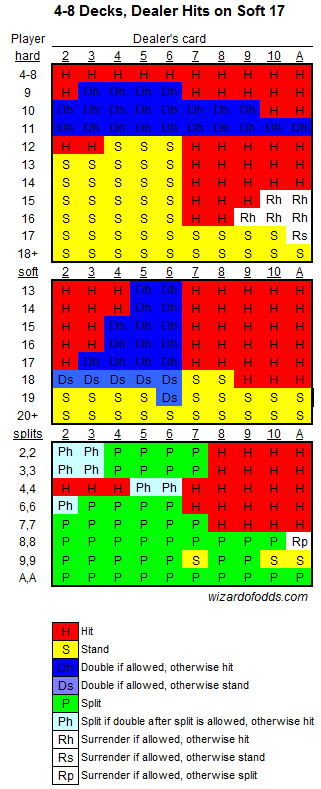
This chart is an example for a Blackjack game that has 4-8 decks and the dealer hits on a soft 17 (most common casino rule). The chart is fairly easy to read as we are taking your total and comparing it to the dealer’s up card to see what you should do.
Let’s look at some examples:
- Say I have a hard total (no aces or the ace is counted as 1) of 16. The dealer’s up card is an 8. Looking at the chart it says I should hit. So I do so. Let’s say I received a 2. Now I have 18. We refer to the chart again. My 18 to the dealer’s up card of 8 says to stand. So I choose to stand. Each move I make results in a new strategy that has to be taken.
- Let’s say I have two 8’s like I mentioned earlier. This is a total of 16 but it’s a pair of 8’s so I look at the bottom of the chart. The dealer’s card is an 8 as well. According to the chart it says I need to split the 8’s. Once your 8’s are split into two separate hands, you use each separate hand as a separate case and compare it to the basic strategy chart. So if one hand I have an 8 and a 9, that’s 17 and the chart says to stand. If the other 8 I receive a 2, that’s a total of 10. The chart tells me I should double down on that hand.
- Let’s say my total is now 15 and the dealer has a 10. The chart says to surrender, but the casino doesn’t allow surrender. So it says “surrender if allowed, otherwise hit” so you decide to hit and receive a 2. You now have 17. The chart says to stand.
- This hand I have an ace and a 6 which results in a SOFT 17 and the dealer has a 6. The chart says to “double down if allowed, otherwise hit.” If you double down your turn is done. If they do not allow doubling down on an ace, then you hit and receive a 6. Now you have a HARD 13 because with the ace as 11 it would go over 21. The chart says to stand if you have a HARD 13 against a 6.
There are so many situations that one can run into which is why memorizing the chart can be difficult. Lucky for you, most casino shops sell a basic strategy card like this at the casino shop. What’s even better is that some tables even allow you to bring this card with you to the table! Dealers may also give you advice on what to do with a certain hand according to basic strategy. The dealers don’t make any more or less money if you win or lose. They would rather you win so that you may tip them with some of your winnings. They may try to help out if they are a seasoned dealer who knows what he/she is doing.
That’s the basis of basic strategy. Following these guidelines can help your money last longer. Now let’s journey through the main event: card counting.
Section IV: A Summary of Card Counting

Remember how I mentioned earlier that if a deck has high cards leftover this favors the player and if there are low cards remaining this hurts the player? Well, card counting keeps track of this in an easier manner. Rather than memorizing all of the cards that have been discarded and the ones that are left in the deck, they use a different method.
Card counters will use different counting methods with some having a better edge than others. The most common counting system is the Hi-Lo count. To use the Hi-Lo count, each card has an assigned value to it when it is revealed on the table. Here are the numbers:
- 2-6: +1
- 7-9: 0
- 10 (includes face cards), ace: -1
Whenever a card is revealed on the table, the count is established. Let’s say we have three players and the dealer playing and the following hands are dealt:
- Player 1: jack / 6
- Player 2: 8 / 2
- Player 3: ace / queen
- Dealer up card: 8
We can see player 3 has a blackjack and is paid out immediately and then the game continues starting with player 1. The minute a card counter sees these cards, he/she establishes the values. Looking at all 7 cards, the jack/queen/ace count as -1, the two 8’s as 0, and the 2/6 as +1. We add all of these values up: (-1) + (-1) + (-1) + (0) + (0) + (+1) + (+1) = -1.
This count is called The Running Count. The -1 tells me that the deck is now more rich in lower cards than higher cards because I have seen more higher cards be discarded. This isn’t a bad count for the player but it isn’t in his/her favor.
Now let’s look at some running count totals and interpret them a bit:
- Running count = +5. This is considered high for the card counter. The deck is rich in high cards which could equate to potential blackjacks for the player (given aces are still in the deck) or simply a strong high number.
- Running count = 0. Neutral stance.
- Running count = -10. This is awful.
We now know the counts tell us if the deck favors the player or not, but how do I use this knowledge to help me out? Depending on the count, I change my betting patterns. So in high counts, since my chances of winning are higher, I want to bet more. If my chances of winning are low, I bet less. THAT is the concept of card counting. You adjust your bets according to the deck.
Card counters still follow Basic Strategy as mentioned above, but they make adjustments to basic strategy according to the count. Referring back to basic strategy chart, if I have a total of 16 and the dealer’s up card is a 7, it tells me I should HIT. However, if I’m counting and I know the deck is filled with high cards currently, I don’t want to hit and risk busting so instead I choose to STAND. There are multiple situations in which you would want to adjust your basic strategy according to the count, but I won’t go into detail on that.
In summary, card counting is used to adjust your bets and to adjust your Basic Strategy decisions. That’s it. There’s also something called the True Count in which the Running Count is adjusted according to the remaining decks in the game that have not been played. This complicates things even further. The math itself is not difficult. It’s all basic arithmetic. What makes card counting difficult is to perform basic strategy, simple calculations, betting, and communicating to the dealer without much hesitation. It’s the multi-tasking aspect of it that makes it difficult and doing all of the math in your head. THAT is the difficult part.
Card counters aren’t made overnight. Much practice is needed in order to have the charts memorized. One exercise to get the hang of card counting is to count down a deck of cards. If using the Hi-Lo system, a deck of cards will add up to 0. In order to practice, you take out one card from the deck and don’t look at it. You then count down the other 51 cards until you get a number. You then predict what the other card is based off of the number you counted to.
So say I take out a card and I count the deck down. I end up with +1. This means the card I pulled out has to be a -1 value which means it’s either a 10, a face card, or an ace. That’s how it’s done. But what’s the hard part? To get the hang of the “language” of card counting, you want to be able to do this quickly. If you can count down an entire deck in about 25 seconds consistently, you’re good to go. That’s essentially 2 cards per second. It’s harder than it sounds. It took me awhile to get there but eventually I did.
Along with counting drills like this, you want to run Blackjack drills by playing some games out and practicing with friends and/or yourself. Practice makes perfect!
Section V: A Personal Card Counting Story
I remember my first gambling trip. I had never gone gambling to any casino anywhere. My mom, brother, and I had planned to go to Las Vegas with my grandma, my aunt, and some of their friends. Once I knew we were going to sin city, I wanted to look up gambling strategies. I had always heard of Blackjack and card counting so I decided to dive into it all.
What I learned quickly is that card counting is NOT how you see it in the movies like 21. It’s not as glamorous and it’s not that lucrative when it comes to making money. Regardless, I pushed through. I read a book or two on it, tried memorizing charts, and performed drills.

The Tropicana in Las Vegas
We stayed at the Tropicana where I had my first experience with any casino and card counting in general. I practiced with the basic strategy chart and the Hi-Lo method. I was very nervous. I had no gambling experience whatsoever. What would the dealer say? Would they pressure me to play? Would the players I play with get annoyed? Would I make a wrong gesture? Casinos are ran with vigilance so this made me nervous.
After practicing over and over again, I took to the tables. It was a 6 or 8 deck $5 minimum table. I knew what to do, but I wasn’t too familiar with the table etiquette of not touching my cards, how bets are placed, etc. I learned all of that as the plays progressed. In the first round of the 6/8 deck, I just focused on Basic Strategy and the table etiquette. The players and the dealer were friendly and helped me out as it calmed me down. I chose not to drink when the cocktail waitress came by as I needed to focus.
After the shuffle I decided to try out my counting. It was easier than I thought. Keeping track of the count was really easy. The hardest part was what I did with the count along with conversing with the dealer and other players. I went through about 2 or 3 more shoes. I started out with $50 and ended up with about $60 or so ($10 profit). It seemed that card counting was working. I was ecstatic!
I informed my mom and my brother that it seems to work. So me and my brother played downstairs in the Tropicana casino. I was winning, and made a profit of $40 or something around that. My brother, not so much. He knew nothing about Basic Strategy and card counting. He was just making guesses. He lost all of his money which I believe was $40-$50. He became very frustrated.
We adjourned to our room. I assured him that if he learned this system he could make better decisions and maybe make some money. He was stubborn at first but I convinced him to give it a try. I showed him my book on card counting that showed the charts and the drills. We practiced through them and did some mock games. I think we kept track of bets on a piece of paper. We had planned to go to downtown Vegas later that day, so we took what he learned and applied it there.

Fremont Street
I cannot recall where we went exactly, but it was either Binions or Fremont casino that we went into. We found a $5 table with a new dealer. The casino and the table were packed and with me and my brother the table was full. We start out with $50 each and begin to play. I was distracted. My counts were off and I was making amateur mistakes. I was losing money but it was my own fault. My brother on the other hand was doing well! He had a big ol’ grin on his face and the patrons sitting with us could see it too. The whole table was pretty jolly. I believe someone hit one of the Lucky Ladies side bet too.
Eventually we had to get off the table and keep roaming around downtown. I lost my $50 but my brother I believe doubled his money or more! He was living proof that smarter choices can be made at the tables and that going off the seat of your pants was not the way to go. That night made up for the money he had initially lost at the Tropicana.

Rio Las Vegas
On our second trip to Vegas with the family we stayed in the Rio but this time I was even more prepared. I had an 8 deck shuffler machine, a shoe to place the decks in, about 12 or more decks of cards that me and my brother planned to do something with as a drill mentioned in one of the books, and we also had a laptop computer. We marked 8 decks of cards from 1 through 416 to help us read how many decks were left in the shoe to calculate the true count.We shuffled cards in the giant shuffler. We used his laptop to keep track of our bets on an excel spreadsheet to see if we made money after 100 plays or so. This was the way we practiced and then we would go apply the concepts at the tables. I found out the Gold Coast had a great double deck game to practice on too. I was on that table for hours and walked off with a black chip which is $100. This was done while tipping the dealer and the cocktail waitress. It was fun. I profited $50 but gained a lot of experience and some casino comps.
I’ve gone to Vegas 5 times so far, and I will be going again. The thrill at the tables is fun and exciting and I can’t see myself becoming sick of it.
Conclusion and Recommended Readings
Card counting is interesting, but it does take a lot of work to master. I still consider myself a novice. Hopefully this entry helped you understand a bit more on card counting. Below is some of the literature I have read regarding counting.
Play Blackjack Like the Pros by Kevin Blackwood: This was the first Blackjack book I ever read. Kevin is really straight forward with a lot of his insight. He doesn’t give too much detail on certain aspects, but I appreciate some of his word play in the book. It’s a very straightforward and to the point book
Blackjack: Play like the Pros by John Bukofsky: I bought this to further expand my knowledge on the subject. John goes into much more detail than what I was used to from Kevin’s book. It was a nice supplement to what I already knew.
Blackjack Blueprint by Rick Blaine: This book is categorized by different colors such as the Red Zone, Black Zone, and so on. Rick divides each chapter into different difficulties. Again, this book filled in some gaps that the other two books were missing and it was still a good read!
Overall, you will get something different from any Blackjack book you read. Much of them will say more of the same, but you learn more from different authors. There are more books out there on the topic too. I plan to read those as well.
That wraps it up. If you have any questions, post them in the comments! You will receive an answer.
Now to the tables you go!
Sources
Basic Strategy Chart. Digital image. Wizard of Odds. N.p., n.d. Web. <http://wizardofodds.com/games/blackjack/strategy/4-decks/>.
Blackjack-01. Digital image. Globe Views. N.p., n.d. Web. <http://globe-views.com/dreams/blackjack.html>.
Blackwood, Kevin. “Chapter 7: The Easiest Game to Beat: Blackjack / Setting the Scene.” Casino Gambling for Dummies. Hoboken, NJ: Wiley Pub., 2006. N. pag. Print.
Cards. Digital image. Mike Aponte. N.p., n.d. Web. <https://mikeaponte.com/card_counting_101/>.
Fremont Street. Digital image. N.p., n.d. Web. <http://mapio.net/s/4835138/>.
Lucky Ladies. Digital image. Prairie Wind Casino & Hotel. N.p., n.d. Web. <http://prairiewindcasino.com/promotions/lucky-ladies-side-bets>.
Rio. Digital image. Destination 360. N.p., n.d. Web. <http://www.destination360.com/north-america/us/nevada/las-vegas/rio>.
Tropicana. Digital image. Destination 360. N.p., n.d. Web. <http://www.destination360.com/north-america/us/nevada/las-vegas/tropicana-las-vegas>.








